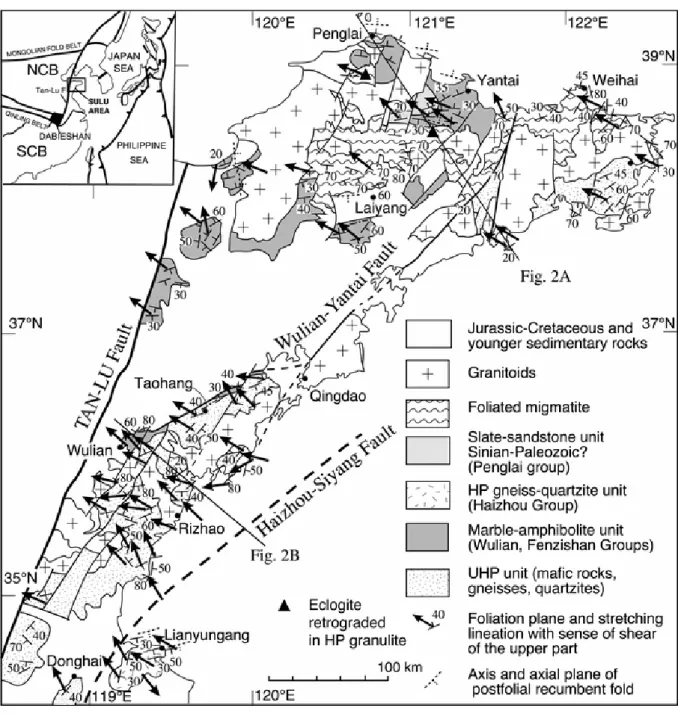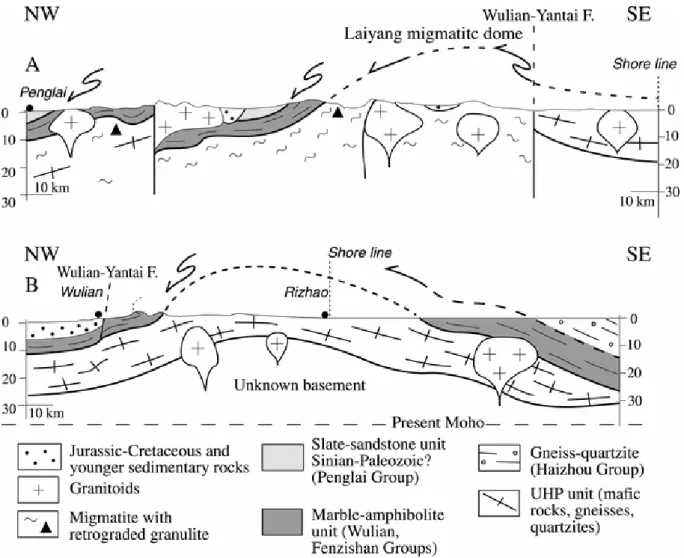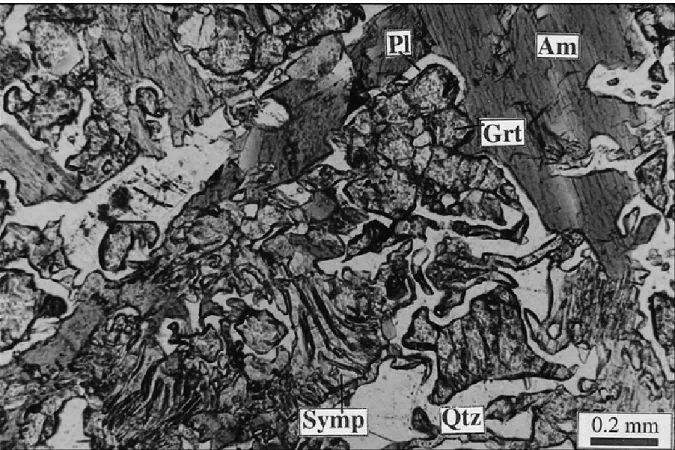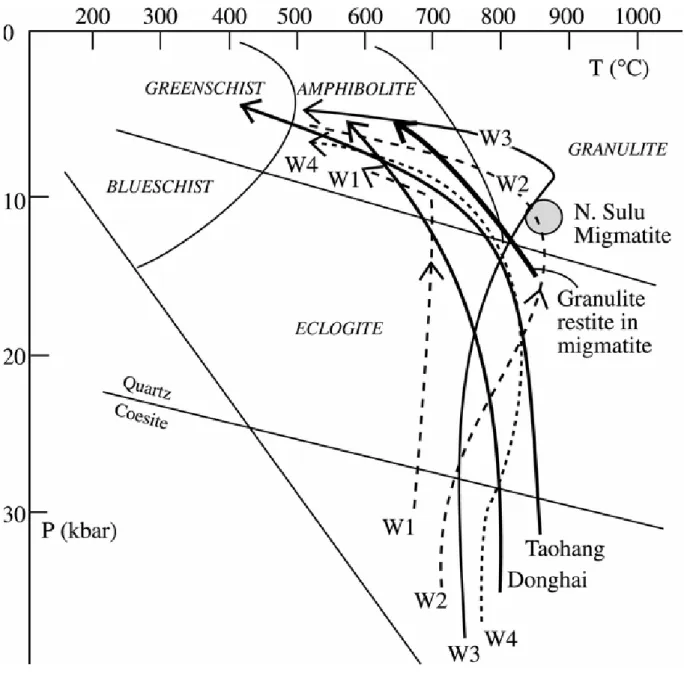HAL Id: hal-00078015
https://hal-insu.archives-ouvertes.fr/hal-00078015
Submitted on 2 Jun 2006
HAL is a multi-disciplinary open access archive for the deposit and dissemination of sci-entific research documents, whether they are pub-lished or not. The documents may come from teaching and research institutions in France or abroad, or from public or private research centers.
L’archive ouverte pluridisciplinaire HAL, est destinée au dépôt et à la diffusion de documents scientifiques de niveau recherche, publiés ou non, émanant des établissements d’enseignement et de recherche français ou étrangers, des laboratoires publics ou privés.
Where is the North China–South China block boundary
in eastern China?
Michel Faure, Wei Lin, Nicole Le Breton
To cite this version:
Michel Faure, Wei Lin, Nicole Le Breton. Where is the North China–South China block boundary in eastern China?. Geology, Geological Society of America, 2001, 29, pp.119-122. �10.1130/0091-7613(2001)0292.0.CO;2�. �hal-00078015�
Where is the North China–South China block
boundary in eastern China?
Michel Faure, Wei Lin, and Nicole Le Breton
Institut des Sciences de la Terre d'Orléans, Bâtiment Géosciences, Université d'Orléans, 45067 Orléans Cedex 2, France
ABSTRACT
The Qinling-Dabieshan belt results from the collision of the North China and South China blocks. The eastern extension of the belt (the Sulu area) consists of several stacked units: from top to bottom, these are (1) a weakly metamorphosed slate-sandstone unit of Neoproterozoic-Paleozoic age, (2) a gneiss-quartzite unit metamorphosed under high-pressure (P) conditions, (3) a marble-amphibolite unit, (4) an ultrahigh-P unit that was very deeply subducted and then exhumed, and (5) a migmatitic dome resulting from the melting of ultrahigh-P rocks. All these units underwent the same deformation, which was characterized by a top-to-the-northwest extensional ductile shearing, during their exhumation. Granulite facies restites in the migmatite are not significantly different from granulitized eclogites derived from the ultrahigh-P rocks. The migmatite exhibits the same structural and petrologic evolution as that determined for the other units. The resemblance of petrologic and structural features and the lack of ocean-basin rock shows that the boundary between the North China block and South China block must be placed north of the Sulu area.
Keywords: suture zone, exhumation, granulite facies, detachment fault, China.
INTRODUCTION
In China, the east-trending Qinling-Dabieshan belt is a wide orogen formed by the collision of the North China and South China blocks (Mattauer et al., 1985, 1991 ; Okay and Sengör, 1992 ; Cong, 1996 ). The Dabieshan, on the east of the chain, is famous for its ultrahigh-pressure (P) metamorphism. The occurrence of coesite eclogite and ultrahigh-P minerals in gneiss demonstrates that the continental crust of the South China block was subducted to more than 100 km depth and afterward exhumed. To the east of the Dabieshan, the orogen is offset by the Tan-Lu fault. Ultrahigh-P rocks crop out 500 km northward in the northern Jiangsu and eastern Shandong Provinces, or Sulu area. There, in spite of several tens of papers dealing with metamorphism of the ultrahigh-P rocks (e.g., Cong, 1996 ; Banno et al., 2000 ; Yao et al., 2000 ), structural data are rare (Wallis et al., 1997, 1999 ), and thus a general tectonic framework is still lacking. It is, however, an essential prerequisite in order to propose any geodynamic scenario.
This paper presents a structural map and crustal-scale cross sections of the Sulu area based on firsthand data. The structural analyses together with a new discovery of high-P granulite in the so-called North China Precambrian basement of the north Jiaodong Peninsula allow us to argue that the boundary between the North and South China blocks must be to the north of the Sulu area.
TECTONIC MAP OF THE JIAODONG PENINSULA
Our field survey in the Jiaodong Peninsula allows us to recognize a stack of tectonic-metamorphic units unconformably covered by Upper Jurassic– Cretaceous volcanic and sedimentary rocks or intruded by Cretaceous plutons. The general structure of the peninsula is somewhat complicated by northeast-southwest–trending normal and left-lateral brittle faults (Shandong Bureau of Geology and Mineral Resources, 1991 ). Among these, the Wulian-Yantai fault (Fig. 1) separates the southeastern Sulu area, where ultrahigh-P rocks are widely exposed, from the northwestern Sulu area, where gneisses, marbles, amphibolites, and migmatites are conspicuous. For this reason, the Wulian-Yantai fault has been considered as the suture zone between the South and North China blocks (Okay and engör, 1992 ; Yin and Nie, 1993 ; Li, 1994 , Cong, 1996 ; Gilder et al., 1999 ; Zhai et al., 2000 ). Prior to the Mesozoic, the Jiaodong Peninsula underwent deep-seated tectonics associated with the stacking of metamorphic allochthons overprinted by a migmatitic dome. From top to bottom, the following units are distinguished (Fig. 1).
Neoproterozoic (Sinian) to Paleozoic(?) Slate-Sandstone Unit
These weakly to unmetamorphosed rocks, called the Penglai Group, are Neoproterozoic (Sinian) or Paleozoic age (Cong, 1996 ) and crop out in the northern part of the Sulu area. The slate-sandstone unit is mapped as unconformably overlying the metamorphic rocks (Shandong Bureau of Geology and Mineral Resources, 1991 ). However, striations on bedding surfaces and recumbent folds argue for a north-directed detachment fault between the two units (Fig. 2).
High-Pressure Gneiss-Quartzite Unit
A gneiss-quartzite unit is found along the sea coast near the Lianyungang City (Fig. 1). The unit is also recognized by drilling below the Holocene sediments. High-P rocks with glaucophane, jadeite, kyanite, and phengite occur sporadically (Cong, 1996 ). The boundary between the ultrahigh- and high-P units, called the Haizhou-Siyang fault, is only known through geophysical data (Cong, 1996 ).
Marble-Amphibolite Unit
Although designated as Wulian or Fenzishan Groups in the north and south sides of the Mesozoic basin, respectively (Shandon Bureau of Geology and Mineral Resources, 1991 ), identical marbles, mafic intrusions, and a few gneisses and metapelites form the marble-amphibolite unit. The presence of a tectonic contact between this unit and the slate-sandstone unit is supported by a metamorphic gap and by the lack of the gneiss-quartzite unit in the northeastern part of Jiaodong Peninsula. Eclogite facies rocks are not reported in this unit, thus we consider that it was never subjected to the P metamorphism. The marble-amphibolite unit overlies the ultrahigh-P unit with a 1–2-km-thick mylonitic contact (Fig. 2B).
Ultrahigh-Pressure Unit
The ultrahigh-P unit consists of mafic rocks, quartzite, gneiss, and marble. Coesite eclogites attest to severe metamorphic conditions (Wang et al., 1993 ; Zhang et al., 1995 ; Cong, 1996 ). The occurrence of jadeite orthogneiss (Hirajima et al., 1993 ) demonstrates that all the continental rocks were deeply subducted. Meter- to kilometer-size garnet lherzolite and pyroxenite bodies record the ultrahigh-P event (Zhang et al., 1994 ). However, these ultramafic bodies do not represent deeply subducted ocean-basin mantle. If not all, then at least some of the ultramafic rocks are crustal-hosted peridotites that correspond to cumulates associated with intracontinental basalts emplaced within the south China continental crust in Proterozoic time. No mafic magmatic rocks or marine sedimentary rocks have been identified. The lack of oceanic crust and mantle allows us to conclude that an oceanic suture is not represented in the Sulu area.
Foliated Migmatite Unit
In the northern part of the Jiaodong Peninsula, north of the Mesozoic basin, foliated migmatite crops out. Typical migmatitic features such as nebulitic structures with contorted leucosome layers and K-feldspar porphyroblasts are locally well preserved, but the most common rock is a foliated diatexite with conspicuous planar and linear fabrics. The Al-Si–rich gneisses could have easily been partially melted to give rise to the leucosome, whereas the abundant amphibolite masses represent the unmelted Fe-Mg–rich restites. This migmatite is seen as the basement of the North China block, but relicts of high-P rocks suggest that it derives from the melting of the ultrahigh-P unit.
STRUCTURAL ANALYSIS AND KINEMATICS
The bulk structure of the Jiaodong Peninsula consists of a succession of southwest-northeast–trending anticlines and synclines. The antiform north of
Laiyang is a migmatitic dome surrounded by the marble-amphibolite and slate-sandstone units (Fig. 2A). The central Jiaodong syncline is filled by Upper Jurassic–Cretaceous deposits. Southwest of Qingdao, the ultrahigh-P unit occupies the core of an antiform (Fig. 2B). Ultrahigh-P rocks constitute the deepest unit exposed. By comparison with Dabieshan (Faure et al., 1999 ), we assume that the ultrahigh-P unit is underlain by non ultrahigh-P gneisses. This is supported by seismic reflection data (Yang, 2000 ).
In every unit, a stretching lineation that trends N130°–N160°E is the dominant feature (Fig. 1). Close to the contact between the marble-amphibolite unit and the slate-sandstone unit, the dikes are deformed into sigmoidal boudins with northwest shearing. The mineral lineation and top-to-the-northwest kinematics are also common in the ultrahigh-P unit. In the upper part of the ultrahigh-P unit, orthogneiss and amphibolites bodies are progressively changed into augen mylonite or ultramylonite. Top-to-the-northwest kinematics are also found in the gneiss-quartzite high-P unit. However, rare top-to-the-southeast senses of shear are also developed near Lianyungang (Fig. 1).
In the migmatite, recrystallization textures of quartz and K-feldspar aggregates indicate that the foliation and lineation were acquired in a postsolidus stage. East and south of Weihai, mylonitic fabrics overprint the migmatite. There, the migmatitic foliation is changed into a flat-lying banded gneiss with northwest-trending stretching lineation and intrafolial folds. This top-to-the-northwest ductile shear zone is coeval with an amphibolite facies metamorphism that overprints the ultrahigh-P event and migmatization. The shear zone is interpreted here as a detachment fault along which the exhumation of the ultrahigh-P rocks occurred.
A second ductile deformation, restricted to the northern area, refolds the foliation and lineation. The orientation and overturning of the postfoliation folds exhibit a divergent dome pattern; i.e., on the west, north, southeast, and south sides of the dome, the folds are overturned to the west, northeast, southeast, and south, respectively. The dome and recumbent folds are covered by undeformed Jurassic rocks.
NEW PETROLOGIC INSIGHTS
High-P granulites reported from Laiyang are considered as Precambrian rocks of the North China block (Zhai et al., 2000 ). New occurrences have been discovered in a remote location with respect to the Wulian-Yantai fault (Fig. 1). These rocks form decimeter- to meter-scale garnet amphibolite blocks enclosed within foliated migmatite. Granulite facies symplectites of clinopyroxene + plagioclase + hypersthene are seen to have developed at the expense of the garnet + clinopyroxene + quartz assemblage (Fig. 3). In a
late stage of amphibolitization, brown amphibole + plagioclase overprinted the symplectite. Garnets are compositionally zoned with an increase in Mg and decrease in Fe contents from core to rim. The symplectite consists of diopside (0.4–0.8 wt% Na2O) and andesine (An28–48). Such a high Na content is
explained by a breakdown reaction of a garnet + Na rich clinopyroxene + quartz assemblage. Thus, the retrograde metamorphism of eclogite appears to be the most likely process to produce this granulitic symplectite. Ultrahigh-P minerals have not been yet observed, but rare radial fractures around quartz inclusions in garnet might indicate that the inclusions are coesite pseudomorphs.
Several pressure-temperature paths have been constructed (Zhang et al., 1995 ; Yao et al., 2000 ; Fig. 4). In the Donghai area, the ultrahigh-P unit was never migmatized, and eclogite was retrograded into amphibolite. Closer to the migmatite, in Taohang (Figs. 1 and 4), the pressure-temperature (P-T) path approaches the granulite facies. In Weihai, ultrahigh-P eclogites enclosed in foliated migmatites show a granulitic overprint (Wang et al., 1993 ; Zhang et al., 1995 ; Zhai et al., 2000 ). The retrograde metamorphism of the Weihai eclogite intersects the P-T area defined for the migmatite (Enami et al., 1993 ). Therefore, from the available petrologic data, it is impossible to separate an ultrahigh-P unit retrograded into granulite facies to the east from a migmatite with granulite facies xenoliths to the west.
DISCUSSION AND CONCLUSIONS
The geometry and kinematics of the deformation phases demonstrate that the north and south parts of the Jiaodong Peninsula shared the same tectonic evolution. In addition to the lack of oceanic-basin rocks in the Jiaodong Peninsula, our work shows that the Wulian-Yantai fault cannot be the suture zone between the North and South China blocks. The contact between the ultrahigh-P and marble-amphibolite units is a flat-lying, top-to-the-northwest ductile shear zone formed during a late stage of exhumation of the ultrahigh-P metamorphic rocks under amphibolite facies conditions. This boundary was reworked as the high-angle, brittle Wulian-Yantai fault in late Mesozoic time.
The metamorphic evolution of the Sulu area must be older than Late Jurassic. This stratigraphic constraint complies well with the radiometric ages of ultrahigh-P metamorphic rocks in the 240–210 Ma range, which is considered to be the date of the pressure peak (Ames et al., 1993 ; Li et al., 1994 ). Moreover, as in the Dabieshan, 90–110 Ma 40Ar/39Ar ages on muscovite,
biotite, hornblende, and K-feldspar confirm the importance of a Late Cretaceous thermal event in eastern China (e.g., Chen et al., 1992 ; Li et al., 1994 ; Eide et al., 1994 ; Lin et al., 2000 ). However, a problem arises when dealing with the geochronology of the migmatite. Zircons extracted from
gneissic migmatite north of Laiyang give dates between 1.5 and 2 Ga (Enami et al., 1993 ; Ishizaka et al., 1994 ). Recent Sm-Nd analyses have provided isochrons from 1.74 to 1.84 Ga (Zhai et al., 2000 ). It is acknowledged that these Paleoproterozoic dates represent the protolith age, but more surprisingly, these isotopic systems do not record any evidence of the Mesozoic events.
The geology of the Sulu area is quite similar to that of the Dabieshan (e.g., Hacker et al., 1995, 2000 ; Faure et al., 1999 ). In both areas, the ultrahigh-P metamorphism is overprinted by a migmatitic dome, and the main ductile deformation is a top-to-the-northwest shearing coeval with amphibolite facies metamorphism. Amphibolite, gabbro, and marine sedimentary rocks cropping out in the northern Dabieshan area are interpreted as the trace of the suture zone between the North and South China blocks. In the Sulu area, the gneiss-quartzite unit, the ultrahigh-P unit, and migmatite dome are correlated with the corresponding units of the Dabieshan, but the marble-amphibolite unit has no equivalent in the Dabieshan. The crustal-scale cross section (Fig. 5) shows that the stack of allochthonous units belongs to the South China block.
Our correlation pattern raises the question of the location of the boundary between the North and South China blocks east of the Tan-Lu fault. Because the boundary cannot be located in the Jiaodong Peninsula, it has to be to the north. These new data have to be taken into account in any forthcoming exhumation models and paleogeodynamic reconstructions.
REFERENCES CITED
Ames, L., Tilton, G., and Zhou, G., 1993, Timing of collision of the Sino-Korean and Yangtse cratons: U-Pb zircon dating of coesite-bearing eclogites: Geology, 21, 239–242.
Banno, S., Enami, M., Hirajima, T., Ishiwatari, A., and Wang, Q., 2000,
Decompression pressure-temperature path of coesite eclogite to granulite from Weihai, eastern China: Lithos, 52, 97–108.
Chen, W., Harrison, T.M., Heizler, M.T., Liu, R., Ma, B., and Li, J., 1992, The cooling history of melange zone in north Jiangsu–south Shandong region: Evidence for multiple diffusion domain 40Ar/39Ar thermal geochronology: Acta
Petrologica Sinica, 8, 1–17.
Cong, B., 1996, Ultrahigh-pressure metamorphic rocks in the Dabieshan–Sulu region of China: Dordrecht, Netherlands, Kluwer Academic Publishers, 224 p. Eide, E.A., McWilliams, M.O., and Liou, J.G., 1994, 40Ar/39Ar geochronology
and exhumation of high-pressure to ultrahigh-pressure metamorphic rocks in east-central China: Geology, 22, 601–604.
Enami, M., Suzuki, K., Zhai, M., and Zheng, X., 1993, The chemical Th-U-total Pb isochron ages of Jiaodong and Jiaonan metamorphic rocks in the Shandong Peninsula, eastern China: The Island Arc, 2,, 104–113.
Faure, M., Lin, W., Shu, L., Sun, Y., and Schärer, U., 1999, Tectonics of the
Dabieshan (eastern China) and possible exhumation mechanism of ultra-high pressure rocks: Terra Nova, 11, 251–258.
Gilder, S., Leloup, P.H., Courtillot, V., Chen, Y., Coe, S.R., Zhao, X., Xiao, W., Halim, N., Cogné, J.-P., and Zhu, R., 1999, Tectonic evolution of the Tancheng-Lujiang (Tan-Lu) fault via Middle Triassic to early Cenozoic paleomagnetic data: Journal of Geophysical Research, 104, 15,365–15,390.
Hacker, B.R., Ratsbacher, L., Webb, L., and Dong, S., 1995, What brought them up? Exhumation of the Dabie Shan ultrahigh-pressure rocks: Geology, 23,, 743–746.
Hacker, B.R., Ratsbacher, L., Webb, L., Ireland, T., Calvert, A., Dong, S., Wenk, H.R., and Chateigner, D., 2000, Exhumation of the ultrahigh-pressure
continental crust in east-central China: Late Triassic–Early Jurassic extension: Journal of Geophysical Research,, 105, 13,339–13,364.
Hirajima, T., Wallis, S., Zhai, M., and Ye, K., 1993, Eclogitized metagranitoid from the Su-Lu ultrahigh pressure province, eastern China: Japan Academy
Proceedings, 69, 249–254.
Ishizaka, K., Hirajima, T., and Zheng, X.S., 1994, Rb-Sr dating for the Jiaodong gneiss of the Sulu ultrahigh-pressure province eastern China: The Island Arc,, 3, 232–241.
Li, S., Wang, Q., Chen, Y., Zhou, H., Zhang, Z., Liu, D., and Qiu, J., 1994, Excess argon in phengite of eclogite: Evidence for comparing dating of eclogite by Sm-Nd, Rb-Sr, and 40Ar/39Ar isotope methods: Chemical Geology, 112, 343–
350.
Li, Z., 1994, Collision between the North and South China blocks: A crustal-detachment model for suturing in the region east of the Tanlu fault: Geology, 22,, 739–742.
Lin, W., Faure, M., Monié, P., Schärer, U., Zhang, L., and Sun, Y., 2000, Tectonics of SE China, new insights from the Lushan massif (Jiangxi Province): Tectonics, 19, 852–871.
Mattauer, M., Matte, P., Malavieille, J., Tapponnier, P., Maluski, H., Xu, Z., Lu, Y., and Tang, Y., 1985, Tectonics of the Qinling belt: Build-up and evolution of eastern Asia: Nature, 317, 496–500.
Mattauer, M., Matte, P., Maluski, H., Xu, Z., Zhang, Q., and Wang, Y., 1991, La limite Chine du Nord-Chine du Sud au Paléozoïque et au Trias: Nouvelles données structurales et radiométriques dans le massif du Dabieshan (chaîne des Qinling): Paris, Académie des Sciences Comptes Rendus, 312, 1227–1233. Okay, A.I., and engör, A.M.C., 1992, Evidence for continental thrust–related exhumation of the ultra-high pressure rocks in China: Geology, 20, 411–414. Shandong Bureau of Geology and Mineral Resources (SBGMR),. , 1991,
Regional geology of Shandong province: Beijing, Geological Publications, 639 p.
Wallis, S., Ishiwatari, A., Hirajima, T., Ye, K., Guo, J., Nakamura, D., Kato, T., Zhai, M., Enami, M., Cong, B., and Banno, S., 1997, Occurrence and field
relationships of ultrahigh-pressure metagranitoid and coesite eclogite in the Sulu terrane, eastern China: Geological Society of London Journal, 154, 45–54. Wallis, S., Enami, M., and Banno, S., 1999, The Sulu UHP terrane: A review of the petrology and structural geology: International Geology Review, 41, 906–920. Wang, Q., Ishiwatari, A., Zhao, Z., Hirajima, T., Hiramatsu, N., Enami, M., Zhai, M., and Cong, B., 1993, Coesite bearing granulite retrograded from eclogite in Weihai, eastern China: European Journal of Mineralogy, 5, 141–152.
Yang, W., 2000, Analysis of deep intracontinental subduction: Episodes, 23, 20–24.
Yao, Y., Ye, K., Liu, J., Cong, B., and Wang, Q., 2000, A transitional eclogite- to high pressure granulite-facies overprint on coesite-eclogite at Taohang in the Sulu ultrahigh-pressure terrane, eastern China: Lithos,, 52, 109–120.
Yin, A., and Nie, S., 1993, An indentation model for the north and south China collision and the development of the Tan-Lu and Honam fault systems,
eastern China: Tectonics, 12, 801–813.
Zhai, M., Cong, B., Guo, J., Liu, W., Li, Y., and Wang, Q., 2000, Sm-Nd geochronology and petrography of garnet pyroxene granulites in the
northern Sulu region of China and their geotectonic interpretation: Lithos, 52, 23–33.
Zhang, R.Y., Liou, J.G., and Cong, B., 1994, Petrogenesis of garnet-bearing ultramafic rocks and associated eclogites in the Su-Lu ultrahigh-pressure metamorphic terrane, eastern China: Journal of Metamorphic Geology, 12, 169–186.
Zhang, R.Y., Hirajima, T., Banno, S., Cong, B., and Liou, J.G., 1995, Petrology of ultrahigh-pressure rocks from the southern Su-Lu region, eastern China: Journal of Metamorphic Geology, 13, 659–675.
FIGURES
Figure 1. Structural and kinematic map of Sulu area. Lineation arrows point toward sense of shear of upper part. HP—high pressure; UHP—ultrahigh pressure; NCB—North China block; SCB—South China block
Figure 2. Cross sections through Sulu area (located in Fig. 1) showing stack of allochthonous units. By analogy with Dabieshan, geometry of ultrahigh-pressure (UHP) unit is considered as few-kilometers-thick slab underlain by gneiss free of UHP assemblages. F is fault
Figure 3. Symplectitic texture of high-pressure granulite formed by retrograde metamorphism of eclogite (south of Penglai, location in Fig. 1). Grt, Pl, Am, Symp, and Qtz are garnet, plagioclase, amphibole, symplectite, and quartz, respectively.
Figure 4. Contrasted pressure-temperature (P-T) paths inferred from different tectonometamorphic units, namely, nonmigmatized ultrahigh-P unit: Donghai (Zhang et al., 1995 ); Taohang (Yao et al., 2000 ); granulitized eclogite in Weihai, W1 (Banno et al., 2000 ), W2 (Wang et al., 1993 ), W3 (Zhai et al., 2000 ), W4 (Zhang et al., 1995 ); granulite restite in migmatite (Zhai et al., 2000 ). Gray circle corresponds to P-T field of migmatite north of Laiyang (Enami et al., 1993 ). Note that P-T path of granulite facies restite does not differ from that of granulitized eclogites
Figure 5. Crustal-scale cross section of Jiaodong peninsula. Suture zone between North China block (NCB) and South China block (SCB) is placed north of migmatitic dome of north Jiaodong. Deep structure of SCB is inferred from seismic data (Yang, 2000 ). Cretaceous plutons have been omitted for clarity




